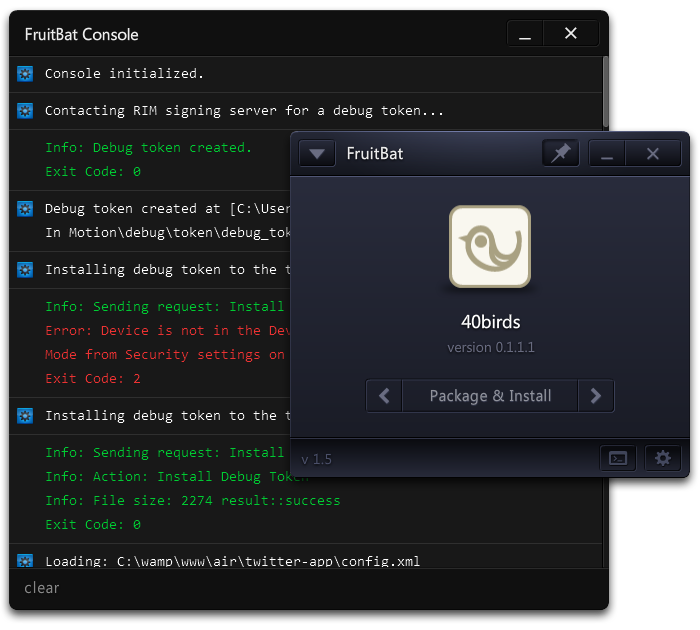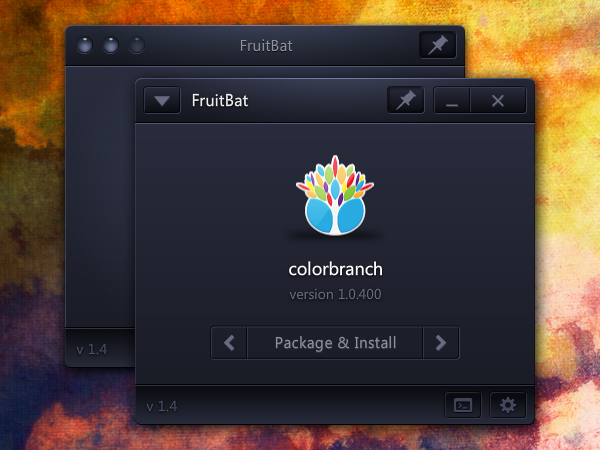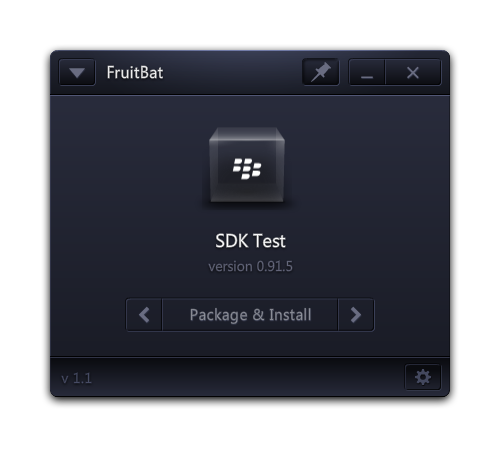Adobe AIR

It has been a while since the last FruitBat update was made available and since then, a lot has changed. BlackBerry 10 is on the way and Tablet OS updated to 2.0 with 2.1 in beta. WebWorks also continues to evolve in the BlackBerry github repository. With all of the activity around BlackBerry development, FruitBat needed some attention to keep up as well as improve some of its basic functionality.

The FruitBat 1.4.0132 update includes the following changes:
- BUGFIX: (Mac Only) Automatic updates did not function in 1.4.0127 (sorry all- you’ll have to download the installer from the site this time). This was fixed and tested in an intermediate unreleased version 1.4.0130.
- BUGFIX: Auto-generated WebWorks ZIP file name could possibly be invalid when attempting to package a WebWorks app. This would cause packaging to fail. All ZIP file names should be fully valid now, every time.
- BUGFIX: Register Signing Keys item in the Publish menu was not linked to its action, so it did nothing when selected. Now, registering signing keys via this menu item should function properly.
- CHANGE: The process for installing debug tokens was changed to allow file selection if the Debug Token Save Location in the Settings/Preferences window did not contain a valid file location.
- NEW: Added messages to the console for:
- loading XML from any of the available options (drag & drop, shortcut key, menu item)
- creating/refreshing the package file list
- updating the main app panel
- installing standalone BAR files
- uninstalling standalone BAR files
Windows users may use the update feature to download and install the update automatically. Mac users should use the download button below for this time. There is no need to uninstall the previous version before installing this one. The old version will simply be replaced on install.

Considering it has been so long, I’ve decided to release a public beta of the in-progress version of FruitBat… and this time something for the Mac folks too! As there is so much new stuff, be sure to check the main page for instructions, though you probably won’t need them because most actions have only one step. How’s that for easy?
This beta installation will expire and no longer run at midnight on December 31, 2011.
Updates have been enabled for all current installations. To install the current version, use “Check for updates” from the Help menu. Settings are not compatible between the two versions, so they will have to be redone via the new Settings window. Update is not required if you would like to stay with version 1.3, despite its display bug.
Download links, release notes, known issues, etc. after the jump.
January – the month of updates! BlackBerry released a new version of the PlayBook SDK and simulator yesterday (0.9.2). With the update, your password is required to interact with the simulator via the command line tools. This update changes the command line interaction slightly to accommodate for that.
Update 02/2011: This version is also compatible Tablet OS SDK version 0.9.3 which was released by RIM on 02/08/2011.
If the command line errors out, check to make sure the clock in the simulator has the correct time, matched to your computer’s clock.

FruitBat 1.1.1453 fixes the package command to ensure the application descriptor file always comes first in the file list, no matter what it is named. This bug would stop some applications from compiling into BAR files.The icon has also been switched for a much simpler, blue version with icon sizes trimmed to only those that Windows will use, shaving around 400K from the download package size.
The update may be downloaded from the FruitBat page or through the in-application updater (Help > Check for Updates).

The first update to FruitBat is ready. This update includes several enhancements as well as compatibility with the newest version of the Tablet OS SDK (0.9.1). Thanks to those of you that reported bugs and errors.
This update should address all of the reported issues that cause FruitBat to not do its job. More info and download link after the jump. This is the last version you should have to download and install manually. Updates are included in this version.
Despite the misinformation floating around out there, the openness of the Flash Platform and the open source Flex SDK make it possible to create Flash and AIR applications without touching a single authoring tool created by Adobe. It also makes it possible for other tools and projects to be used in conjunction with the Adobe-produced tools. You’re in control of your preferred toolset, and it’s a beautiful thing.
One application that is part of my toolset is FlashDevelop. It is an open source development environment for Flash Platform content. It includes features for both ActionScript (2 & 3) development as well as Flex (3 & 4) development for both Flash Player and AIR and is on par with Flash Builder in several areas and surpasses it (in my opinion) in other areas. For final output, it uses the open source Flex and AIR SDKs to compile SWF and AIR files that are identical to those produced in Adobe authoring.
Of course, the very day that BlackBerry announced that Flash Player 10.1 and AIR 2.5 would be fully supported on the BlackBerry PlayBook in the browser and as apps, I downloaded all of the required SDKs and set out to build my first PlayBook application. After downloading, installing and donating *wink* to the FlashDevelop project, the following will get you started with building your own PlayBook app.

A couple of weeks ago at Adobe MAX, Research In Motion announced that Flash and its cousin Adobe AIR would be first class citizens on its upcoming tablet, BlackBerry PlayBook. In fact, several of the default media applications to ship on the tablet are written using AIR.
Of course, this is exciting because we can use familiar technologies to create applications. Even though AIR is a runtime on top of the operating system, I’ve seen quotes to the effect of “AIR and Flash are embedded through and through, all the way to the silicon.” This should bring a performance boost between the hardware and AIR apps.
With being able to create AIR apps for PlayBook, we need tools. Of course Adobe offers a nice selection with Flash Professional, Flash Catalyst and Flash Builder, but one of the great things about Flash content creation is that you’re not limited to only the Adobe applications. The Flex SDK, which includes much of the same functionality as the Adobe applications, is available at no charge from Adobe Open Source. Everything you need to create Flash applications is in the package. Add your favorite editor and you’re ready to write ActionScript or MXML applications for both AIR and the Flash Player plugin.

Following my article on loading OpenX ads in Adobe AIR applications, I’ve written a very simple class to make it a little easier. This should be able to load in both image and HTML/text based banners with no problem.

For AIR applications that have access to an internet connections, delivering ads via OpenX is very easy with just a little code. For this basic implementation, we’ll use AIR’s built-in WebKit browser, which accepts JavaScript delivery perfectly, by using an instance of the HTMLLoader class. This is the same approach I’ve taken with my own AIR application, Brush Manager, which is authored in Flash CS4 Professional. Being completely ActionScript based, the same code should be able to be used in the Flex environment (maybe with very few modifications for public and private identifiers). HTML/JavaScript based applications should be able to use a similar approach, if the ads aren’t already integrated completely into the code base for the app.